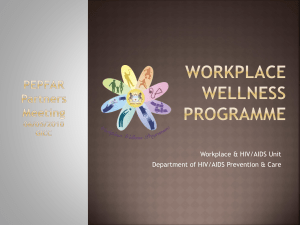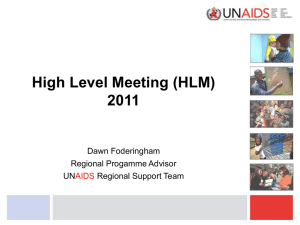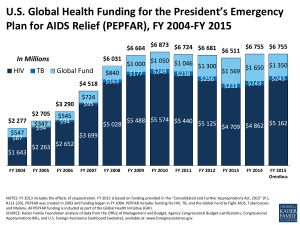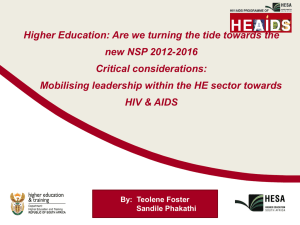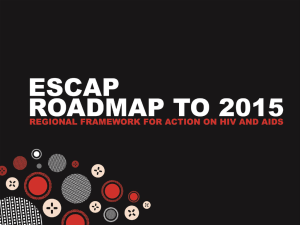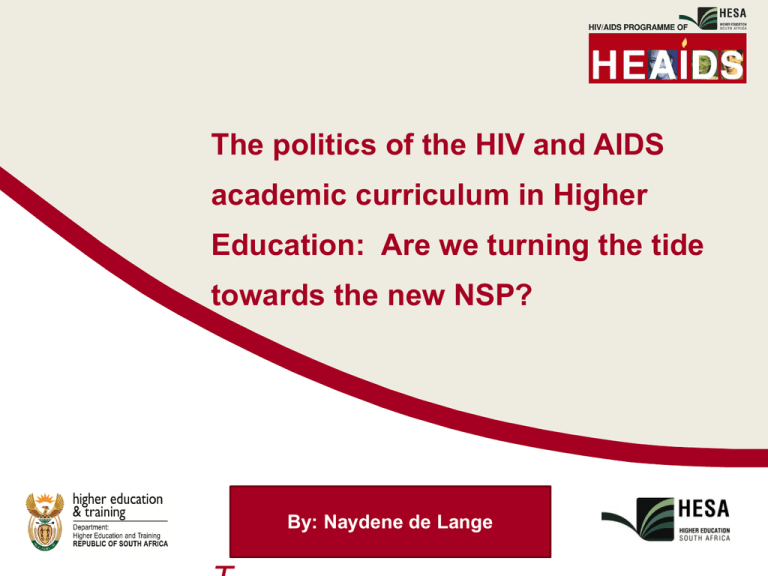
The politics of the HIV and AIDS
academic curriculum in Higher
Education: Are we turning the tide
towards the new NSP?
By: Naydene de Lange
Background: Why is an academic HIV and AIDS
curriculum required?
Our South Africa!
Our university students – graduates for the future
HIV Prevalence and Related Factors (HEAIDS, 2010d)
Mean HIV prevalence for students = 3.4 %
EC
6,4%
KZN
6,1 %
Free State
5,3%
NSP 2012-2016 Vision
Gauteng
2,2%
NW
2,2%
Limpopo
2,2%
WC
1,1%
•
•
•
Zero new HIV and TB infections
Zero deaths associated with HIV
and TB
Zero discrimination associated
with HIV, STIs and TB
The face of the ‘statistics’ and the
purpose of the university
Courtesy: Photographs from NMMU Publications webpage
Guiding Policy Framework
Four Strategic Objectives:
1. Address social and structural
barriers to HIV, STI and TB
prevention, care and impact
2. Prevent new HIV, STI and TB
infections
3. Sustain health and wellness
4. Increase protection of human
rights and improve access
to justice
Revised
2012-2016
Comprehensive
Institutional
Policy on HIV
and AIDS
“A strategy for
curriculum
responsiveness
by all faculties
is developed and
implemented.”
(HEAIDS, 2008,
p.25)
HE HIV and AIDS policy framework
indicates that HEIs should …
“… develop graduates with relevant personal and
professional skills on HIV and AIDS who can become
leaders in society and are able to address the impact of
HIV and AIDS among all communities” (HEAIDS, 2008,
p.15).
Translating into HIV and AIDS competency + responsible
citizens
Are some of us at HEIs dithering …
Dr Beetroot by Jonathan Shapiro
Copyright: Jonathan Shapiro
… with the roll out of an HIV & AIDS
academic curriculum?
Dr Beetroot by Jonathan Shapiro (adapted by N de
Lange) Copyright: Jonathan Shapiro
What do we mean by curriculum/
‘curriculum-in-the-making’?
• “… ‘curriculum-in-the-making’ recognizes the significance of
curriculum as a process”
•
it includes “…pedagogical, curricular and evaluation issues”
• “The curriculum model that we draw on is informed by William Pinar’s
(2004, p.186) metaphor of curriculum as “an extraordinarily
complicated conversation” (HEAIDS, 2010b, p. 2)
What is happening at HEIs in terms of making
space for HIV and AIDS in the academic
curriculum?
Two key studies
Module/Materials/Reader and
Curriculum-in-the-making
Creating a space in the curriculum
Study : Key findings
•
‘Champion’
interviews
18
Universities
DVC and
Dean
interviews
•
8
Universities
• Situational
analysis
Finding
“…HEIs have responded in diverse ways to HIV/AIDS …
ranging from complete silence to systematically developed HIV/AIDSrelated policies and programmes, research, service provision, peer
education, and various academic responses, including the integration of
HIV/ AIDS into the curriculum” (HEAIDS, 2010c, vi).
as module with section on HIV and AIDS
stand-alone HIV and AIDS-focused module
a set of assignments
a weekend workshop within a module
Integration in 19 disciplinary areas
DVC and
Dean
interviews
“Almost every possible disciplinary area is
represented as having “something on the go”
when it comes to
integration, and indeed
Applied English
Language
Studies
Law
Agriculture
Business
Mathematics
Education
Human Ecology
Community
Development
Communication
Commerce
Chemistry
Pharmacy
Food
preparation and
nutrition
Civil
Engineering
Environmental
Sciences
Health
Sciences
Psychology
Science
Education
Hotel
Management
Religion and
Theology
almost every possible
disciplinary area had
at least one champion
somewhere in the
country.
(HEAIDS, 2010c, p. viii).
Also Qualifications and Programmes
• Inter-and Multi-Disciplinary Qualifications in HIV/AIDS
• Dedicated Modules in HIV/AIDS Qualifications
• Post-Graduate Programmes
• Short-Learning Courses
Crucial points
‘Champion’
interviews
1. The varying roles of champions
“One of the points about the place of champions in a particular faculty relates to
the question of ‘drivers’ within a faculty or school…. Clearly, as several of
these instructors in support units commented, it takes a faculty champion to
motivate for the inclusion of HIV/AIDS into the course or programme in the
first place, but there are a variety of models that can be followed and it does
not necessarily mean that everyone is integrating HIV/AIDS all the time and
into all courses.”
“This finding may make the integration process more manageable.” (HEAIDS,
2010c, vii-ix).
2. There are at least 3 types of knowledge that instructors identified as critical in
their courses:
Personal
knowledge in
relation to
HIV/AIDS
Workplace
knowledge
and
HIV/AIDS
Disciplinary
knowledge
and
HIV/AIDS
3. The ‘champion’ as caring academic and personal, professional and social
responsibility
“It was not enough for instructors to simply identify areas of their courses where they could
find a disciplinary-related component that linked to HIV/AIDS. They had to feel strongly
that this was a socially responsible thing to do.…to connect directly to the lives of the
students … they worried about the future of their students…”
How can I possibly
teach just about
poultry when my
students are coming
to me about
testing positive? My
first concern is to help
them stay alive!
This speaks to a changing role of educators in HEIs in the age of AIDS and in particular
the idea of the caring professional and one who sees themselves having a preventative
role in relation to the students’ lives.” (HEAIDS, 2010c, vii-ix).
Main propositions in response to the
HIV and AIDS academic curriculum
1.
HIV and AIDS academic curriculum is every one’s concern.
2.
HIV and AIDS academic curriculum is applied uniquely in each institution and
is influenced by context.
3. The way academics think and feel about their role and about complex issues
such as sexuality, homosexuality, sex (aspects key to HIV and AIDS) is crucial
to the integration of HIV and AIDS into the curriculum.
4. A ‘curriculum-in-the-making’ is central to integration and should be seen as a
process rather than a product, as a ‘curriculum-in-action’ and a ‘curriculumin-use’.
5. Participatory pedagogies/approaches are key to the curriculum as they open
up space for dialogue, instead of a teacher’s monologue.
6. Evaluation, self-study and making our teaching our research is key to
strengthening integration of the academic curriculum and requires synergy
between our teaching and research.
7. Maintaining mainstreaming, integration, and infusion is not cheap.
The challenge and a choice…
The challenge for universities lie in imagining how to contribute to the
public good in the age of AIDS, and how to re-imagine educating the
student population an already brimful academic curriculum in order
to safeguard every student and to turn the tide against HIV and AIDS,
as envisaged in the three zeros of the NSP (2012-2016):
zero new infections from HIV;
zero deaths associated with HIV and AIDS;
zero discrimination.
Questions to engage within as a
sector/group discussion sessions
1. What are the key challenges to integrating HIV and AIDS into the
academic curriculum at your HEI?
2. What are the ‘enablers’ / ‘game changers’ to address the challenges
and strengthen the HIV and AIDS academic curriculum across
institutions, across faculties and across disciplines?
3. What do you think needs to be done to encourage academics across
disciplines to increase and sustain the momentum of curriculum
integration?
References
HEAIDS (2010a). Summary Report – The roles of educators in mitigating the impact of the
HIV/AIDS pandemic on the education system in South Africa, December 2009. Pretoria:
Higher Education South Africa.
HEAIDS (2010b). HIV and AIDS in Teacher Education - Evaluation Report of a Pilot Project in
South African Higher Education Institutions. Pretoria: Higher Education South Africa.
HEAIDS ( 2010c). Creating space for HIV and AIDS in the curriculum – A Rapid Assessment of
curricular responses in South African Higher Education Institutions. Pretoria: Higher
Education South Africa.
HEAIDS ( 2010d). HIV Prevalence and related Factors: Higher Education Sector Study, South
Africa, 2008-2009. Pretoria: Higher Education South Africa
HEAIDS (2008). Policy Framework on HIV and AIDS for Higher Education in South Africa.
Pretoria: Higher Education South Africa
SANAC (2011). National Strategic Plan for HIV, STIs and TB, 2012-2016, South Africa.

